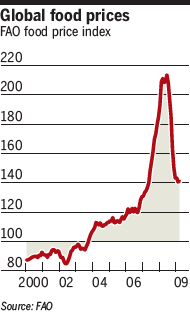The world faces a permanent food crisis and global instability unless countries act now to feed a surging population by doubling agricultural output, a report drafted for ministers of the Group of Eight nations has warned.
The policy document, prepared by the G8’s Italian presidency for its first ministerial meeting on agriculture and seen by the Financial Times, says “immediate interventions” are needed.
It warns that global agriculture production must double by 2050 for the world’s fast-growing population to have enough to eat and to deal with the effects of climate change. Otherwise, the report says, the food crisis of the past two years in much of the world “will become structural in only a few decades”.
The report says that further food crises will have “serious consequences, not merely on business relations but equally on social and international relations, which in turn will impact directly on the security and stability of world politics”.
Agriculture ministers from G8 nations are due to meet this month in Italy. The meeting was prompted by last year’s spike in the prices of agricultural commodities, including wheat and rice, which triggered riots in more than 30 countries, from Bangladesh to Haiti.
Global food pricesAlthough agricultural commodities prices have since fallen by as much as 40-50 per cent, they are still well above their pre-crisis levels. Domestic prices in many developing countries remain close to last year’s records and have risen even further in some African countries.
“The issue of price volatility remains a crucial element for the world’s food security,” the report says. “There is a need for a fast increase of agricultural production in developing countries.”
James Bolger, chairman of the World Agricultural Forum and former prime minister of New Zealand, said the G8 meeting on agriculture was “hugely” significant. Political unity on agriculture was critical to avoid “random efforts by individual countries to secure their own food security”, he said
Tom Vilsack, US agriculture secretary, said Washington planned to double financial aid for agriculture development in poor countries to $1bn next year.
“We face the reality of a world population that’s growing by 79m people each year, a rate that may … challenge our capacity to grow and raise enough food,” he said yesterday ahead of the International Food Aid Conference in Kansas City.

